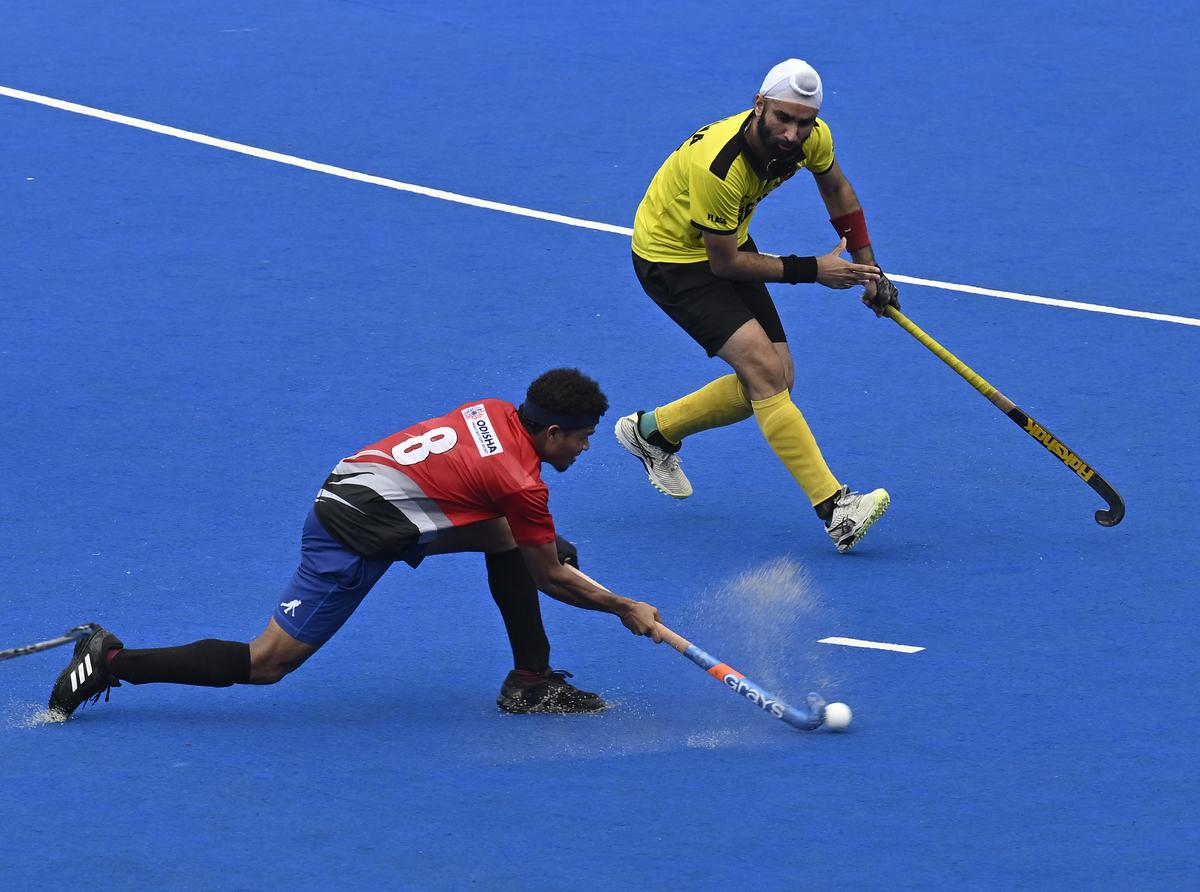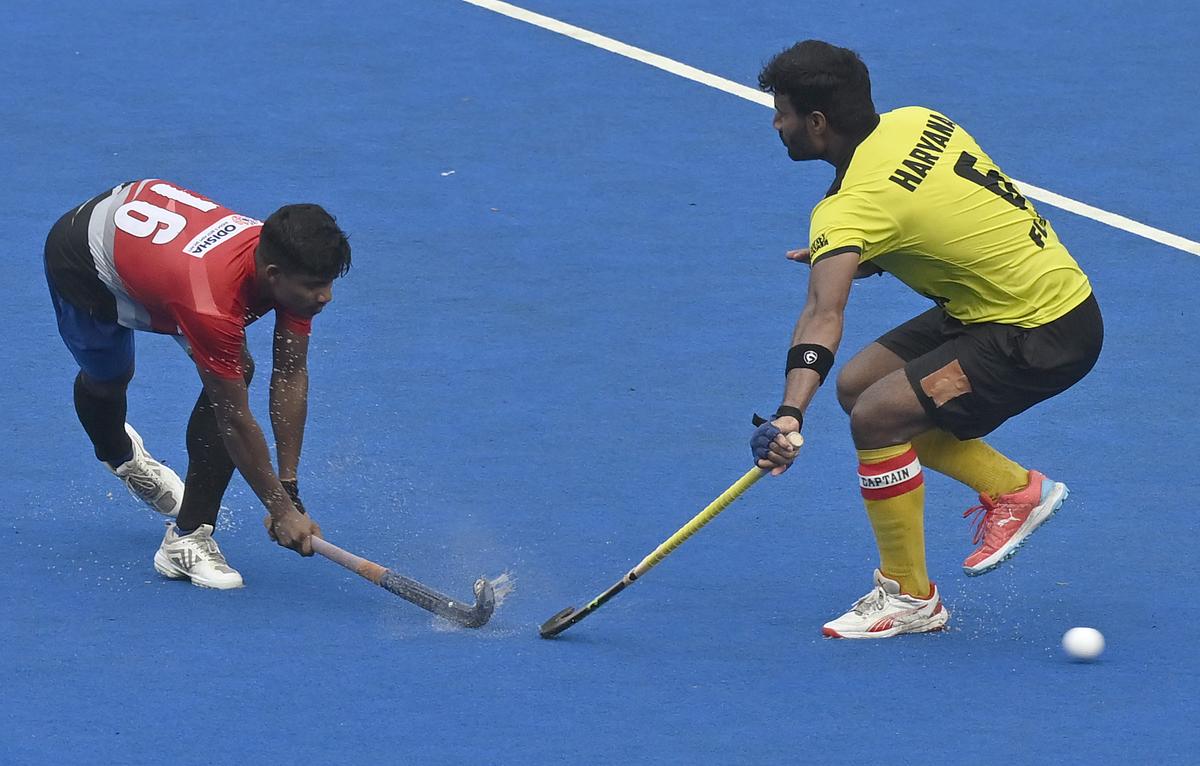On February 15, 2018, Indian hockey history was rewritten. Odisha became the first state government to commit to a five-year sponsorship of the sport. Then-Odisha Chief Minister Naveen Patnaik announced the project with Hockey India in New Delhi, describing it as a “gift to the nation” during the country’s darkest period in national sport.
In the last six years, the eastern Indian state on the shores of the Bay of Bengal has been the biggest promoter of hockey in the country. From funding the men’s and women’s national teams to hosting matches and building the largest hockey stadium in the world ahead of the 2023 Hockey World Cup, the state and its government have done it all.
On Saturday, Odisha won the 14th Hockey India Senior Men National Championship 2024 in its first-ever final appearance by defeating two-time champion Haryana 5-1.
Odisha’s gold medal win added a new chapter to its hockey legacy, but for coach Bijay Kumar Lakra’s young team, its significance extends far beyond the sports field.
ALSO READ | Odisha thumps Haryana 5-1 to win title, UP bags bronze
At the heart of this accomplishment is Odisha’s deep-rooted hockey culture which has thrived in Sundargarh and the adjacent tribal lands for over a century. Introduced by Christian missionaries and the British army in the late 19th century, hockey quickly took root in Odisha’s tribal communities.
The tribals’ natural athleticism and speed were soon recognized, leading to the establishment of intra-village tournaments known as Khasi Cups, with live animals as prizes. This unique tradition continues to this day.
Hockey has become an integral part of tribal life in Odisha. The state’s 2024 victorious team is a testament to this, with 17 of the 18 players hailing from Sundargarh district. Only the first-choice goalkeeper, Sahil Kumar Nayak from Cuttack, is an exception.
Despite a rich hockey tradition, Odisha has struggled to field strong national teams in the past. This was primarily due to the majority of talented players being tied to departmental teams. However, with the recent restriction of national championships to state teams, Odisha has been able to assemble formidable squads in the last couple of editions.
Such is the depth of talent that Odisha’s 22-year-old defender, Cyril Lugun, had to represent Manipur, scoring a hat-trick to oust defending champion Punjab in the quarterfinals.
Odisha’s triumph was made more special with the Hockey India president watching from the grandstands. Dilip Tirkey, India’s most capped hockey player with 412 international appearances and a native of the same district, serves as an inspiration to all players. He conveyed his delight at this success.
“Every child in Sundargarh plays hockey, it is the most popular sport all over Odisha. I’m very proud of this achievement. Sundargarh has always produced good players. The state government has done a lot for hockey, it provides the best facilities and now all the best players from the state are playing together,” said the former India captain to Sportstar.
With an average age of 22, with only four players over 25 and the oldest being 26, it was by far the youngest team to have reached the knockout stage of the tournament.
With two national team players Shilanand Lakra and Nilam Sanjeep Xess, along with six more players from the junior and developmental national camps, Odisha had one of the fittest teams in the tournament.
Shilanad, who has over 30 international caps, returned to the Indian squad in the India-Germany Test Series last month after missing over six months due to a knee injury which had to be operated on.

Lakra Shilanand (L) of Odisha scores a goal against Haryana during the 14th Hockey India Senior Men National Championship final.
| Photo Credit:
VEDHAN M/The Hindu
Lakra Shilanand (L) of Odisha scores a goal against Haryana during the 14th Hockey India Senior Men National Championship final.
| Photo Credit:
VEDHAN M/The Hindu
The 25-year-old forward was the player of the match in both semifinal and final, scoring a hat-trick in the latter, to help his team to the top step of the podium. “I’m very happy. We played with intensity and the juniors were very good throughout the campaign.
“We executed all our plans perfectly. Almost all of us are from Sundargarh, where hockey is a way of life,” said an emotional Shilanand after the final.
Shilanand also emphasised that playing local tournaments instils a never-give-up attitude in players at a young age.
“From a young age, we play tournaments in our villages with live animals as prizes. Those tournaments play a big role in shaping us and teaching us not to give up even if the odds are against you,” he added.
Odisha’s organised structure and intense play have impressed spectators and opposing coaches alike. Its relentless use of substitutions, reminiscent of international hockey, has further set it apart.
“Odisha has a very fit team, their intensity is like international hockey. They also have some very talented players. They just come at you all the time,” said Manipur coach Moirangthem Rinash Meitei after Odisha knocked his team out of the semifinal.
Odisha’s path to victory wasn’t without its hurdles. After dominating the pool stage by scoring 26 goals scored and conceding only three, it faced a tough quarterfinal against Karnataka. The match ended in a 3-3 draw, leading to a penalty shootout where it prevailed 3-1.
In the semifinal against Manipur, Odisha went behind but showed character by coming back to win the match 4-2. However, in the final, Odisha’s dominance was evident, and it capitalised on its attacking opportunities.
Odisha’s exceptional penalty corner defence was a key factor in Haryana struggling to convert its chances. It limited Haryana to just one goal from 10 penalty corners.
To neutralise Haryan’s lethal penalty corner routines, the Odisha coach used both rushers Kerobin Lakra and Amit Kumar Toppo together. 21-year-old Sudeep Chirmako, who scored six field goals in the tournament, formed a brilliant partnership with Shilanand as Odisha’s quick and precise counter-attacks diminished Haryana’s hopes of a comeback.

Sudeep Chirmako (L), who scored six field goals in the tournament, formed a brilliant partnership with Shilanand as Odisha’s quick
| Photo Credit:
VEDHAN M/The Hindu
Sudeep Chirmako (L), who scored six field goals in the tournament, formed a brilliant partnership with Shilanand as Odisha’s quick
| Photo Credit:
VEDHAN M/The Hindu
Overwhelmed with emotion after the match, Coach Bijay Kumar, a veteran of Odisha hockey, dedicated the victory to the state’s relentless love for the game and its people.
“This is the first time Odisha has won the senior men’s nationals. We wanted to dominate the final and we did that. This victory is for the people of Odisha, who have always supported hockey,” said the coach, who also hails from the same village as Tirkey.
If hockey in Odisha begins in the village mud fields, its way forward is in the state-run hockey academies, or ‘hostels’ as locals call them.
In the last three years, these academies have grown from three to 25 in the state to nurture promising talents. Players from around the state are scouted for the academies.
“In the hostels, we train the young players and after graduating from one hostel they go to the next level hostel, where there are more facilities like psychology and nutrition. That eventually leads to the junior state or national team camps,” added Bijay Kumar.
Hockey runs deep in the tribal soul of this mineral-rich state. Its legacy continues, birthing new hockey prodigies for India. As it continues to invest in hockey infrastructure and player development, the future of Indian hockey appears brighter than ever before.






